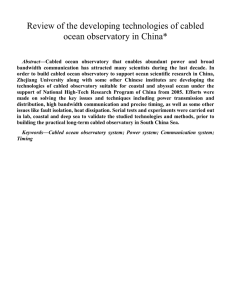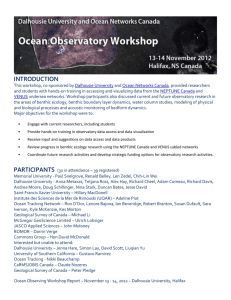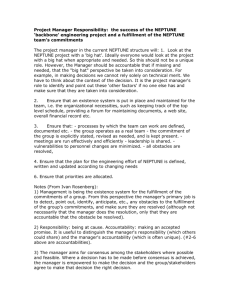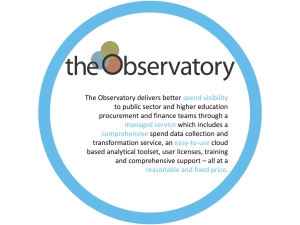Understanding Planet Earth's Processes: Transformative, Real
advertisement
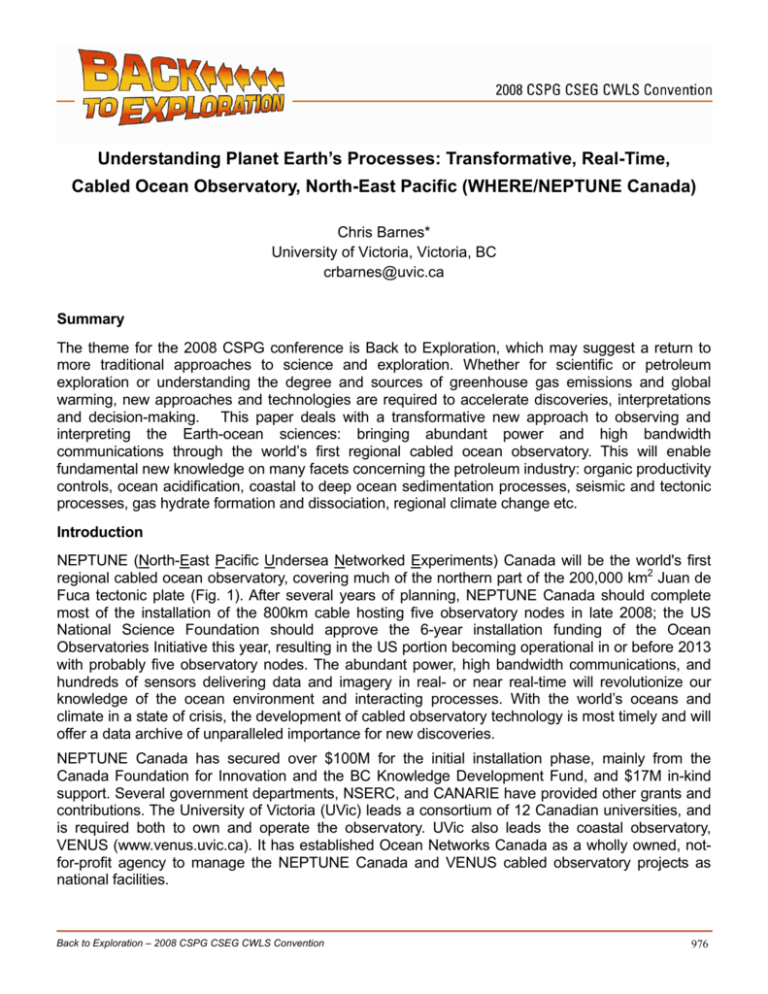
Understanding Planet Earth’s Processes: Transformative, Real-Time, Cabled Ocean Observatory, North-East Pacific (WHERE/NEPTUNE Canada) Chris Barnes* University of Victoria, Victoria, BC crbarnes@uvic.ca Summary The theme for the 2008 CSPG conference is Back to Exploration, which may suggest a return to more traditional approaches to science and exploration. Whether for scientific or petroleum exploration or understanding the degree and sources of greenhouse gas emissions and global warming, new approaches and technologies are required to accelerate discoveries, interpretations and decision-making. This paper deals with a transformative new approach to observing and interpreting the Earth-ocean sciences: bringing abundant power and high bandwidth communications through the world’s first regional cabled ocean observatory. This will enable fundamental new knowledge on many facets concerning the petroleum industry: organic productivity controls, ocean acidification, coastal to deep ocean sedimentation processes, seismic and tectonic processes, gas hydrate formation and dissociation, regional climate change etc. Introduction NEPTUNE (North-East Pacific Undersea Networked Experiments) Canada will be the world's first regional cabled ocean observatory, covering much of the northern part of the 200,000 km2 Juan de Fuca tectonic plate (Fig. 1). After several years of planning, NEPTUNE Canada should complete most of the installation of the 800km cable hosting five observatory nodes in late 2008; the US National Science Foundation should approve the 6-year installation funding of the Ocean Observatories Initiative this year, resulting in the US portion becoming operational in or before 2013 with probably five observatory nodes. The abundant power, high bandwidth communications, and hundreds of sensors delivering data and imagery in real- or near real-time will revolutionize our knowledge of the ocean environment and interacting processes. With the world’s oceans and climate in a state of crisis, the development of cabled observatory technology is most timely and will offer a data archive of unparalleled importance for new discoveries. NEPTUNE Canada has secured over $100M for the initial installation phase, mainly from the Canada Foundation for Innovation and the BC Knowledge Development Fund, and $17M in-kind support. Several government departments, NSERC, and CANARIE have provided other grants and contributions. The University of Victoria (UVic) leads a consortium of 12 Canadian universities, and is required both to own and operate the observatory. UVic also leads the coastal observatory, VENUS (www.venus.uvic.ca). It has established Ocean Networks Canada as a wholly owned, notfor-profit agency to manage the NEPTUNE Canada and VENUS cabled observatory projects as national facilities. Back to Exploration – 2008 CSPG CSEG CWLS Convention 976 Alcatel-Lucent was contracted to design, manufacture and install the NEPTUNE Canada subsea infrastructure, with a 25-year lifespan. An 800km loop of backbone cable/repeaters/branching units was installed in fall 2007, over 11 weeks and involving three vessels, connecting with UVic’s Port Alberni shore station. Alcatel-Lucent will install the nodes in fall 2008 and spring 2009, together with the secondary cables, junction boxes and instruments, followed by testing, security protocols with the Canadian and US navies, and commissioning. Significant challenges during the installation phase have included: securing adequate funding; the innovative design of the nodes, junction boxes and vertical profiler; the route survey over challenging topography; building in-house a Data Management and Archive System (DMAS) that also incorporates an observatory control system; periodic reduction in scope and aspirations; and developing collaborative relationships, including those with the Canadian and US navies, the commercial fisheries, and the First Nations. A series of science workshops during the conceptual design and construction phases, along with external reviews, helped shape a program of community experiments with many focused on the five (with a sixth currently unfunded) sites and others plate-wide in scope. The five principal research themes are: plate tectonics and earthquake dynamics; fluid fluxes in the oceanic crust and gas hydrates in the accretionary margin; oceanclimate dynamics and impact on fisheries; dynamics of the deep sea ecosystems; and engineering and computational research applications. The NEPTUNE Canada Cabled Ocean Observatory and Initial Experiments The entire observatory is designed for at least 25-30 years; individual instruments are expected to be deployed for at least 5 years. Data from instruments will be delivered via the shore station through a 10Gb/s line to the Operations and Data Management centre at UVic and from there, through the Internet, to researchers, industry, decision-makers and the public throughout the world. With the dedicated involvement of interdisciplinary science teams, the following types of initial experiments and instruments are being developed. At the Endeavour Segment of the Juan de Fuca spreading ridge, complex interactions among volcanic, tectonic, hydrothermal and biological processes will be quantified where new volcanic seafloor is created at the western edge of the Juan de Fuca plate. The region (approximately 300 km off British Columbia) has been the site of intensive investigation for more than 20 years, for example of the chemical-biological linkages of black-smoker chimneys and their chemosynthetic biotas. NEPTUNE Canada will benefit both ongoing and new experiments with the real-time monitoring capability of the network: coordinated continuous data in response to episodic events such as earthquakes and intrusions will be recorded across a suite of instruments. These instruments include temperature-resistivity-hydrogen probes, microbial incubators, seismometers, digital cameras and a fluid sampler. A regional circulation experiment extending 250m up into the 2200m water column will characterize hydrothermally driven water mass movement; 4 arrays will consist of current sensors, temperature and salinity sensors, and an Acoustic Doppler Current Profiler (ADCP). At the abyssal plain site (ODP 1027), in 2660 m water depth, we will be connecting to existing Ocean Drilling Program borehole monitoring systems. Circulation obviation retrofit kits (CORKs) will monitor in real-time the changes in crustal temperature and pressure, particularly as they relate to events such as earthquakes, hydrothermal convection or regional plate strain at this mid-plate site. A seismic network, which includes a broadband seismometer at this site, will provide high-resolution information on tectonic processes such as earthquakes and strain across the Juan de Fuca plate. This in turn gives context to many other processes such as fluid movement through the crust and slope stability on the continental margin. Back to Exploration – 2008 CSPG CSEG CWLS Convention 977 A tsunami system will be an array of sensitive bottom pressure recorders (BPRs) deployed at this and other sites to allow determination of open ocean tsunami amplitude, propagation direction and speed. Data from this system will complement information from other tsunami sensors around the North Pacific. A site on the mid-continental slope (ODP 889; 1260m deep) off south-central Vancouver Island is rich in shallowly buried gas hydrates. The objectives are to monitor changes in hydrate distribution, depth, structure, properties and venting, particularly related to earthquakes, slope failures and regional plate motions. Characterization of these will employ geophysical instruments including a controlled source electromagnetic (CSEM) system, a seafloor compliance system (gravimeter) and an acoustic sensor to detect release of methane gas bubbles into the water column. A broadband seismometer will help pinpoint movements associated with Juan de Fuca subduction zone below. Farther south along the continental slope, Barkley Canyon allows quantification of changes in biological and chemical activity associated with nutrient and sediment transport around the shelf/slope break and through the canyon to the deep sea. In the water column of this site, NEPTUNE Canada will study coupling of complex currents with planktonic blooms, the base of the fisheries foodchain. The observatory’s real-time continuous data will allow an understanding how this coupling relates to variability in oceanographic processes, and how it responds to long-term climate change. A dynamic water column (400m) profiler will acquire water properties using a CTD, oxygen sensor, fluorometer, transmissometer, nitrate sensor, carbon dioxide sensor, multi-frequency acoustics package, and an upwelling/downwelling radiometer. Bottom-mounted instruments will consist of an upward-looking 150 kHz ADCP and a pressure sensor. A complex continental slope benthic ecology experiment (to 900m water depth) is designed to interface with water column and sediment transport observations in Barkley Canyon. This will examine changes in seafloor communities related to the transfer of energy and nutrients from the water column to the seafloor, and through the channelling action of the canyon (e.g. downward sediment transport, upward nutrient transport or seasonal upwelling). Equipment at four sites and will include: acoustic current meters, sediment traps, rotary sonar systems, plankton pumps, video cameras, high-resolution still cameras, CTD’s, fluorometers, a microbial metabolic sensor package, and a laser optical plankton counter. A hydrophone will be deployed in the vicinity of the canyon, which will be able to detect slope failures and marine mammals. In addition, outcropping hydrate mounds in this area allow study of their accretion and degradation using in situ temperature probes, rotary still cameras and a crawler. The tracked crawler will carry a CTD, methane sensor, an optical system, a video system to quantify gas bubbles, and a webcam to control vehicle movements. At Folger Passage, located on the continental shelf near the entrance to Barkley Sound, the objectives are to: identify the factors that control biological productivity both within the water column and at the seafloor; evaluate the effects that marine processes have on fish and marine mammals; and provide learning opportunities for students, researchers and the public, many of whom will be working and studying at the nearby Bamfield Marine Science Centre. Ocean floor instruments (100m water depth) will consist of an ADCP, a multi-frequency bioacoustic sensor, an oxygen sensor, a temperature/salinity sensor, and a hydrophone. Instruments deployed on a pinnacle (20m water depth) will include an array of cameras, upward- and downward-looking high-frequency ADCPs and a light sensor. Back to Exploration – 2008 CSPG CSEG CWLS Convention 978 Conclusions NEPTUNE Canada will transform our understanding of biological, chemical, physical, and geological processes across an entire tectonic plate from the shelf to the deep sea. Real-time continuous monitoring allows scientists to capture the variation and episodic nature of these natural processes in a way never before possible. This in turn will allow an understanding of the complex relationships among these processes, whether earthquakes, sedimentation, fishstocks, or marine response to climate change. Opportunities abound for: extending and expanding the network and instrument arrays; international partnerships with other emerging cabled observatories; commercial innovation and demonstration; educational and outreach programming; collaboration with the Ocean Tracking Network project; and nurturing applications/technologies for monitoring pollution, port security, linking offshore oil fields, renewable resource management, and using the long time-series of data essential to improve public policy formulation. NEPTUNE Canada invites researchers, educators, institutions, international partners, and industry to consider participating in the observatory (neptune@uvic.ca; www.neptunecanada.ca). Figure1: NEPTUNE Canada’s 800km cabled ocean observatory system Back to Exploration – 2008 CSPG CSEG CWLS Convention 979
